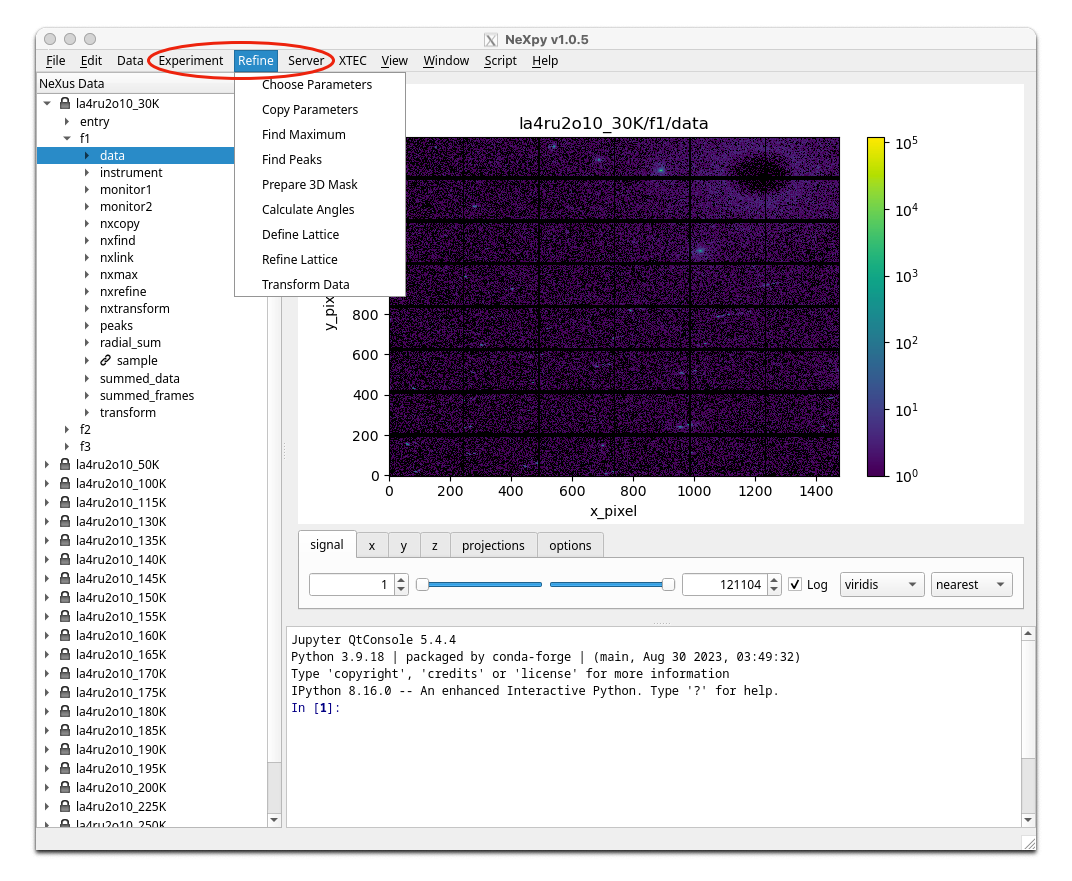Installation¶
Currently, NXRefine must be installed from source by cloning the NXRefine Git repository:
$ git clone https://github.com/nexpy/nxrefine.git
Then use standard Python tools to build and/or install a distribution from within the source directory:
$ python -m build # build a distribution
$ python -m pip install . # install the package
In the near future, NXRefine will be uploaded to the PyPI server so that it can be installed without downloading the source code.
Required Libraries¶
The following packages are listed as dependencies.
Library |
URL |
|---|---|
NeXpy |
|
nexusformat |
|
cctbx-base |
|
pyfai |
|
sqlalchemy |
|
psutil |
|
persist-queue |
Note
The CCTBX library cannot currently be installed using ‘pip’, so it cannot be listed as a dependency in ‘setuptools’. It has to be installed either using conda or by building from source.
NeXpy¶
Although much of the NXRefine workflow can be performed using command-line scripts, it is recommended that they are used in conjunction with the Python-based GUI, NeXpy. Once NXRefine has been installed, NeXpy will automatically import a set of plugins that add three menu items to the NeXpy menu bar.
Experiment
Dialogs to set up experiment directories, initialize NeXus templates, perform powder calibrations, create NeXus files for linking to the scans and storing data reduction results, and, if necessary, import existing scan data.
Refine
Dialogs to define data reduction parameters, perform peak searches, refine crystal orientations, and prepare the reciprocal space grids for the transformed data.
Server
Dialogs to manage workflow operations on existing data, view server logs, and edit default settings for future experiments.
Note
If the NXRefine menu items do not appear in the menu bar, check the NeXpy log file (“Show Log File” in the Window menu) for any error messages preventing the plugin from being loaded.
The menus will be described in more detail in subsequent sections.
CCTW¶
CCTW (Crystal Coordination Transformation Workflow) is a C++ package written by Guy Jennings. It is launched as a separate process by NXRefine, which uses the experimental metadata to define the settings file used to define the input and output grids. It has to be separately installed.
Initial Setup¶
In order to allow NXRefine to be used by multiple users on a single machine or cluster, a common directory is defined to store log files, task queues, and default settings. The location of this directory should be defined immediately after installing NXRefine for the first time. Since the files in this directory are modified by NXRefine commands that could be run by multiple users, it is recommended that all such users are members of the same group. When initialized by a member of that group, the files in the server directory have group read/write permissions by default.
The location of the server directory is initialized on the command line by the ‘nxserver’ command:
$ nxserver -d /path/to/parent
This will create a directory at /path/to/parent/nxserver containing
the files that are required by NXRefine server.
Note
If the supplied path already ends in nxserver, it will not
be appended.
Once the server directory has been initialized, it is necessary for its location to be defined for other users. This can be done in one of two ways.
If NXRefine is being configured by a system administrator, it is possible to use a system-wide environment variable,
NX_SERVER, to to define the path to the server directory. Alternatively, this environment variable could be added to each user’s login script.The
nxservercommand used to initialize the server directory also adds a hidden file to the user’s home directory,~/.nxserver/settings.ini, which contains the server directory path. If the server directory already exists, the command can be run again by other users without affecting the initial directory. In principle, it only needs to be run once by each user, although it could also be added to a login script if preferred.Note
If the
NX_SERVERenvironment variable is defined, it takes precedence over the path in~/.nxserver/settings.ini.
NXRefine uses file-based locking to prevent corruption of data files.
This system is provided by the
nexusformat package, which defines
the directory to contain the lock files using the NX_LOCKDIRECTORY
environment variable. It is recommended that this directory be placed
within the server directory.
Note
The NeXpy GUI has a settings file that can be used to define the lock directory, but it is overridden by the environment variable if it is defined. This allows system administrators to set up a unique lock file directory for all their users.
User Support¶
If you are interested in using this package, please contact Ray Osborn (ROsborn@anl.gov). Please report any bugs as a Github issue, with relevant tracebacks.
